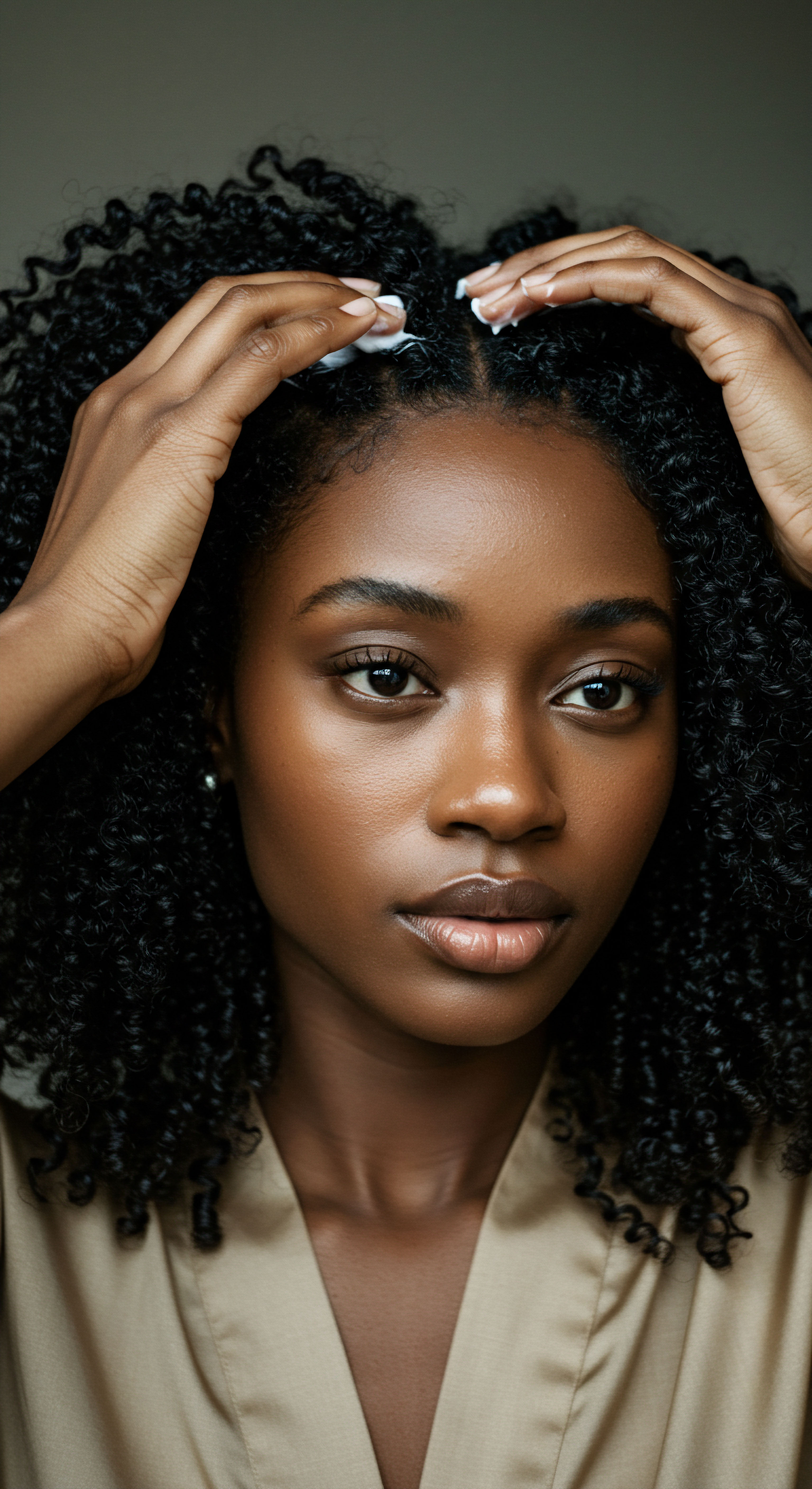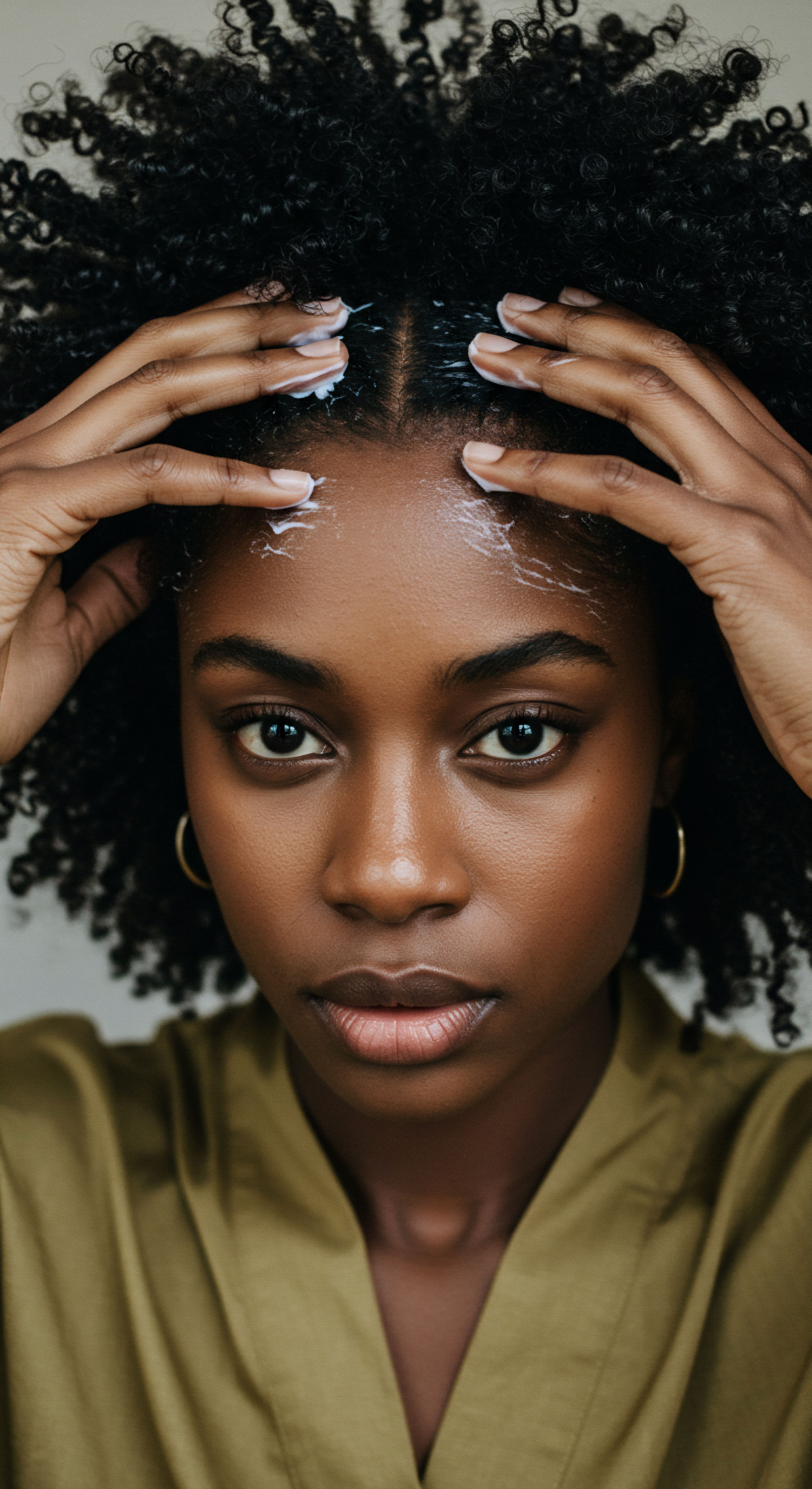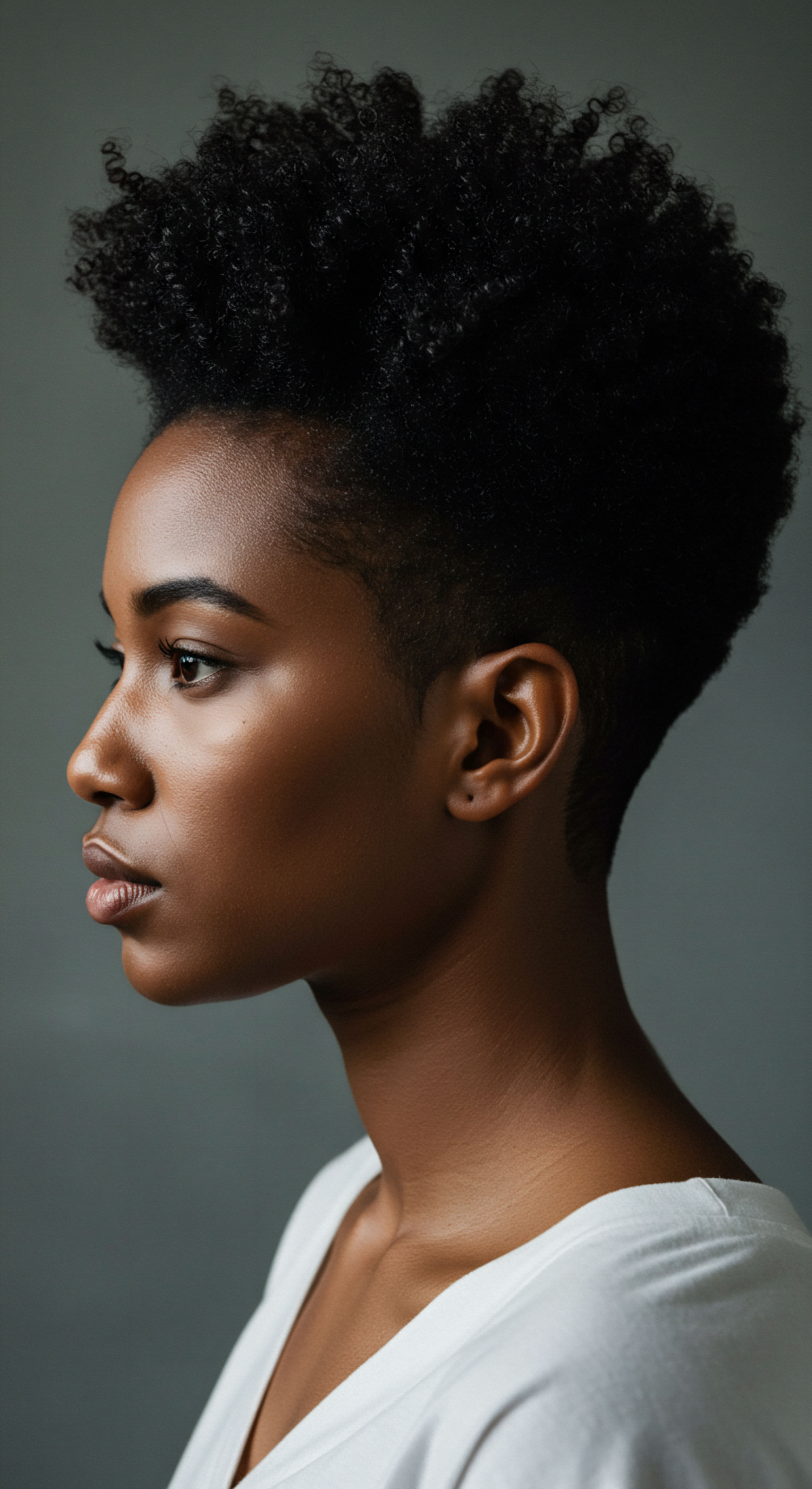
Roots
The whisper of history often carries profound truths, particularly when we listen closely to the stories held within ancient beauty practices. Consider for a moment the sands of ancient Egypt, where the sun held dominion, and personal presentation was not merely a matter of vanity but a reflection of status, hygiene, and spiritual alignment. For the people of this venerable civilization, hair care was a ritual, a science, and an art form all at once.
They sought to preserve their crowning glory against the harsh desert elements, to signify their place in society, and even to prepare for the afterlife. Our exploration begins at this fundamental level, seeking to unearth the primary ingredients that formed the bedrock of their hair care regimens, understanding their purpose, and recognizing the deep connection between these ancient practices and our own contemporary pursuit of hair health.

What Did Ancient Egyptians Use to Cleanse Their Hair?
While modern cleansing rituals involve a dizzying array of shampoos and conditioners, ancient Egyptians relied on simpler, yet remarkably effective, substances. The concept of a foaming cleanser as we know it today was absent, but cleanliness held a high regard. Evidence points to the use of water, certainly, but often enhanced with naturally occurring compounds.
- Natron ❉ This naturally occurring mineral salt, a mixture of sodium carbonate, sodium bicarbonate, sodium chloride, and sodium sulfate, served multiple purposes in ancient Egypt, including cleansing. It was likely dissolved in water for bathing and general hygiene, extending to hair and scalp purification. Its mild abrasive and alkaline properties would have aided in removing oils and impurities.
- Plant Extracts ❉ Though direct “shampoo” recipes are scarce, various plant extracts with saponin-like properties or mild cleansing actions were likely utilized. These could have included parts of the acacia tree or other local flora known for their cleansing attributes.

What Oils Hydrated Ancient Egyptian Hair?
The dry, arid climate of Egypt necessitated powerful moisturizing agents to combat dehydration and maintain hair suppleness. Oils were paramount, serving as both conditioners and styling aids. These liquid gold elixirs were integral to daily routines, providing shine, softness, and protection.
- Castor Oil ❉ A consistent presence in ancient Egyptian hair care, castor oil was highly valued for its conditioning and strengthening properties. It was used to promote hair growth and add luster. Cleopatra herself is said to have used castor oil to maintain her iconic, glossy dark hair.
- Almond Oil ❉ This lightweight oil was frequently applied to keep hair silky smooth and moisturized. Its emollient qualities would have helped to soften hair and reduce breakage, particularly important for those with textured strands.
- Moringa Oil ❉ Revered as the “miracle oil,” moringa oil was prized for its light texture and rich antioxidant content. It nourished the scalp and supported overall hair health.
- Pomegranate Oil ❉ Extracted from tiny seeds, this golden oil offered deep nourishment and hydration, acting as a natural shield against environmental damage from the scorching sun. It also carried cultural significance, representing renewal and vitality.
- Olive Oil ❉ Though perhaps more commonly associated with ancient Greek and Roman beauty, olive oil also found its place in Egyptian cosmetic practices, used to moisturize skin and likely hair.
- Sesame Oil ❉ Another plant-derived oil used for moisturizing skin and hair, indicating a broad reliance on readily available natural resources for beauty regimens.
Ancient Egyptians meticulously selected natural oils, recognizing their protective and beautifying properties in the desert climate.

The Role of Fats in Styling
Beyond liquid oils, animal and plant fats played a surprising role in ancient Egyptian hair styling, acting as a form of “hair gel” to hold elaborate coiffures in place. Research has brought to light the sophisticated application of these substances.
A study conducted by Natalie McCreesh and her colleagues at the University of Manchester examined hair samples from 18 mummies, some dating back 3,500 years. Their analysis, published in the Journal of Archaeological Science, revealed that nine of these mummies had hair coated in a fatty substance. This substance contained biological long-chain fatty acids, including palmitic acid and stearic acid, suggesting its use as a styling product to preserve hairstyles in both life and death. This discovery underscores a remarkable continuity in the desire to maintain styled hair, bridging the ancient world with modern practices.
| Ingredient Castor Oil |
| Key Benefit Promotes growth, adds shine, strengthens hair. |
| Ingredient Almond Oil |
| Key Benefit Softens, moisturizes, reduces breakage. |
| Ingredient Moringa Oil |
| Key Benefit Nourishes scalp, lightweight, rich in antioxidants. |
| Ingredient Pomegranate Oil |
| Key Benefit Deep hydration, environmental protection. |
| Ingredient Olive Oil |
| Key Benefit Moisturizes skin and hair. |
| Ingredient Sesame Oil |
| Key Benefit Conditions and softens hair. |
| Ingredient These natural oils were fundamental to maintaining hair health in a challenging environment. |

Ritual
Stepping beyond the simple identification of ingredients, we approach the ‘Ritual’ of ancient Egyptian hair care, a realm where daily practices and deeply held beliefs converged. It was here that the raw materials of the desert were transformed into potions and applications, meticulously performed to achieve not just physical beauty, but also a deeper sense of self-care and societal belonging. The routines were a quiet affirmation of status, health, and a connection to a world where every action held meaning. We consider the methods, the artistry, and the pervasive presence of hair care within their lives, moving from the foundational knowledge to its practical, repeated expression.

How Were Hair Dyes Utilized?
The desire to alter hair color is not a modern phenomenon. Ancient Egyptians embraced natural dyes, not only to enhance their appearance but also to conceal signs of aging, such as graying hair.
- Henna ❉ Derived from the dried and ground leaves of the Lawsonia plant, henna was a cornerstone of ancient Egyptian hair coloring. It imparted a reddish tint and was also valued for its conditioning properties, helping to strengthen hair. Henna was mixed with water or oils to create a paste applied to the hair, offering a vibrant, lasting color.
- Indigo and Turmeric ❉ While henna provided red tones, other plant extracts like indigo and turmeric were used to achieve different shades, including darker hues.
- Less Conventional Methods ❉ Some historical accounts even mention the use of less palatable ingredients, such as boiled blood of a black ox or calf, mixed with oil, in an attempt to darken gray hair. While such remedies might seem unusual to modern sensibilities, they underscore the lengths to which ancient Egyptians would go to preserve their desired aesthetic.

What Treatments Addressed Hair Concerns?
Ancient Egyptians were acutely aware of hair concerns, including hair loss and thinning, and developed various remedies to address these issues. These treatments often combined a range of natural ingredients, reflecting a deep understanding of the properties of local flora and fauna.
For hair growth, some papyri describe remedies involving ingredients like chopped lettuce applied to bald patches. Other prescriptions combined equal parts of fir oil with other oils or fats. A more complex remedy, found in the Ebers Papyrus, involved a mixture of lion fat, hippo fat, crocodile fat, cat fat, snake fat, and mountain ibex fat, all combined and applied to the scalp. While the efficacy of some of these animal-derived ingredients remains debated by modern science, their inclusion highlights a comprehensive approach to hair wellness that considered every available resource.
Hair care in ancient Egypt transcended mere aesthetics, acting as a profound cultural and personal ritual.

How Did Ancient Egyptians Manage Hair Removal?
Smooth, hairless skin was a symbol of purity, youth, and social status in ancient Egypt, for both men and women, including priests and the aristocracy. This led to the development of sophisticated hair removal techniques.
- Sugaring (Halawa) ❉ One of the most well-known and enduring methods was sugaring, or “halawa.” This sticky paste was made from simple, natural ingredients ❉ Sugar, Water, and Lemon Juice. The mixture was heated until it reached a thick, amber consistency, then applied to the skin and quickly removed, pulling hair from the roots. This method was gentle, effective, and remains popular today.
- Depilatory Creams ❉ Beyond sugaring, evidence suggests the use of early depilatory creams, though their exact compositions varied. Some historical records speak of mixtures that could include ingredients like wax, lime powders, and grass wastes.
The widespread practice of hair removal also contributed to the popularity of wigs. Many Egyptians, particularly those of higher status or priests, would shave their heads for hygiene reasons, avoiding lice infestations in the hot climate, and then wear elaborate wigs made from human hair or plant fibers.
| Ingredient Henna |
| Purpose Hair dye (reddish tones), conditioning. |
| Ingredient Indigo |
| Purpose Hair dye (darker tones). |
| Ingredient Turmeric |
| Purpose Hair dye (yellow/golden tones). |
| Ingredient Animal Fats |
| Purpose Styling "gel" to hold hairstyles. |
| Ingredient Beeswax |
| Purpose Used in hair lotions and to affix wigs. |
| Ingredient These ingredients provided both aesthetic enhancement and practical styling solutions. |

Relay
To truly comprehend the significance of ancient Egyptian hair care, we must move beyond simple descriptions of ingredients and practices. We are called to a deeper consideration, where science, cultural intelligence, and the enduring human connection to personal presentation converge. The interplay of environmental necessity, social stratification, and spiritual belief shaped their approach to hair, giving rise to methods that were both ingenious and, at times, startlingly unconventional. This section serves as a conduit, relaying the complexities and less apparent dimensions of their hair rituals, drawing upon the subtle threads of research and historical context to build a more complete understanding.

What Did the Archeological Evidence Reveal About Hair Styling?
Archaeological findings provide compelling physical evidence that augments textual accounts, offering tangible insights into ancient Egyptian hair practices. Analysis of mummified remains has allowed modern scientists to directly examine the hair and any substances applied to it, revealing a sophisticated approach to styling and preservation.
For example, research on mummies from the Dakhleh Oasis cemetery, dating from Greco-Roman times, revealed that hair was often styled with a fat-based substance. This “hair gel,” composed of long-chain fatty acids like palmitic and stearic acid, served to maintain elaborate coiffures not only in life but also in preparation for the afterlife. This finding suggests a profound continuity of aesthetic concern beyond mortal existence.
Moreover, evidence of hair curling using metal implements and the widespread use of hair extensions and wigs crafted from human hair or sheep’s wool indicate a vibrant culture of hair artistry. The preservation of these styles, even after millennia, speaks volumes about the effectiveness of their chosen ingredients and techniques.
The meticulous preservation of hairstyles on mummies attests to the ancient Egyptians’ advanced understanding of hair care chemistry.

How Did Social Status Shape Hair Practices?
Hair in ancient Egypt was far more than a biological attribute; it was a powerful visual signifier of social status, age, and even religious devotion. The choices made regarding hair length, style, and adornment were deeply embedded within societal norms.
While priests often shaved their heads for ritual purity and to avoid lice, they would frequently wear wigs to signify their status. Elite men and women sported elaborate wigs, often scented with perfumes, as a display of wealth and power. These wigs, sometimes adorned with gold strands, beads, and flowers, were meticulously crafted from human hair, which was a valuable commodity. In contrast, non-elite individuals generally wore their natural hair, which was often a reddish-brown, distinct from the jet-black wigs favored by the elite.
Children, too, had a distinctive hairstyle ❉ the “side-lock of youth,” where their heads were shaved or cut short except for a single, long lock of hair. This style was worn by both boys and girls until puberty, marking their transition into adulthood. The removal of this side-lock was sometimes part of a rite of passage, offered to deities like Horus, signifying separation from childhood.

Did Hair Care Ingredients Also Serve Medicinal Purposes?
The ancient Egyptian approach to ingredients was inherently holistic, often blurring the lines between cosmetic application and medicinal benefit. Many substances used for hair care were also recognized for their therapeutic properties.
For example, the widespread use of Castor Oil was not only for shine and growth but also for its perceived ability to strengthen hair follicles and address scalp health. Its rich content of Vitamin E and fatty acids would indeed provide nourishment. Similarly, Honey, a common ingredient in hair masks and treatments, was valued for its soothing and moisturizing properties, beneficial for both hair and scalp.
Even seemingly unusual ingredients found in ancient remedies for hair loss, such as those listed in the Ebers Papyrus, reflect a trial-and-error approach to understanding the properties of various animal fats and plant extracts. While some of these might appear unconventional by today’s standards, they represent an empirical observation of nature’s offerings, seeking solutions for conditions like baldness. The integration of these ingredients into daily rituals suggests a belief in their power to maintain not just beauty, but also overall well-being, recognizing the scalp as an extension of the body’s health.
The Ebers Papyrus, a medical text dating to around 1550 BCE, offers a window into the medicinal applications of ingredients for hair. It lists various remedies for hair disorders, including twelve specific medical remedies to treat hair loss. These remedies often combined fats from different animals, such as lion, hippo, crocodile, cat, snake, and mountain ibex, mixed with oil and applied to the scalp.
While modern science might question the direct efficacy of some of these specific combinations for hair regrowth, this practice highlights a sophisticated, albeit empirically driven, attempt to address physiological concerns through natural means. The emphasis on scalp health as a prerequisite for hair growth, evident in their use of nourishing oils and treatments, resonates strongly with contemporary trichology.
The deep connection between beauty, hygiene, and health in ancient Egypt meant that many hair care ingredients had dual functions. This holistic view meant that a substance applied for cosmetic appeal might also be believed to offer protection from disease or to promote vitality. The practice of hair removal, for instance, using sugar, water, and lemon, was driven not only by aesthetic preferences for smooth skin but also by a desire for cleanliness in a hot climate, reducing the risk of parasitic infestations. This demonstrates a pragmatic yet sophisticated understanding of the interaction between personal care and environmental conditions.
The meticulous attention to hair care in ancient Egypt, backed by archaeological finds and historical texts, underscores a society that deeply valued personal presentation, not as a superficial concern, but as a significant aspect of health, status, and spiritual readiness. Their inventive use of natural ingredients, from nourishing oils to ingenious styling agents, speaks to a profound connection with their environment and a timeless pursuit of beauty and well-being.

Reflection
As we close this journey through the ancient Egyptian world of hair care, a sense of quiet admiration settles upon us. The ingenuity, the reverence for nature, and the sheer dedication to personal presentation that characterized their practices continue to echo through the ages. Their ingredients, drawn from the earth and its creatures, speak of a profound attunement to their surroundings, a resourceful spirit that found beauty and healing in what was readily available.
We find ourselves contemplating the enduring human desire for self-expression, for care, and for the symbolic power held within our strands. The ancient Egyptians, with their oils, clays, and plant dyes, remind us that the pursuit of radiant hair is a timeless quest, one deeply rooted in culture, science, and the quiet ritual of tending to ourselves.

References
- Ball, P. et al. (2002). “Sex determination from hair ❉ A study of ancient Egyptian hair.” Journal of Archaeological Science.
- Chun, H. S. & Park, K. M. (2013). “A Study on the Hair Removal Culture of Ancient Egypt.” Journal of the Korean Society of Cosmetology, 19(1), 125-134.
- Fletcher, J. (1995). “Ancient Egyptian Hair ❉ A Study in Egyptology and Hairdressing.” Manchester University Press.
- Grapow, H. (1958). “Grundriss der Medizin der Alten Ägypter V ❉ Die medizinischen Texte.” Akademie Verlag.
- Kamal, H. (1991). “The Ancient Egyptian Medicine.” Madbouli Library.
- McCreesh, N. R. et al. (2011). “Ancient Egyptian Hair Gel ❉ Analysis of a Fatty Substance from Mummified Hair.” Journal of Archaeological Science, 38(12), 3505-3509.
- Tassie, G. J. (2000). “Hair-Offerings ❉ An Enigmatic Egyptian Custom.” Papers from the Institute of Archaeology, 11, 89-100.
- Valdesogo Martin, R. (2003). “The Social and Ritual Contextualisation of Ancient Egyptian Hair and Hairstyles from the Protodynastic to the End of the Old Kingdom.” UCL Discovery.
- Wengrow, D. (2006). “The Archaeology of Early Egypt ❉ Social Transformations in North-East Africa, 10,000 to 2650 BC.” Cambridge University Press.